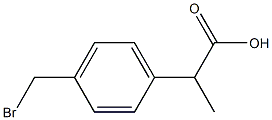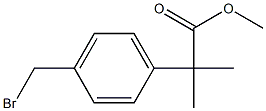4-(BROMOMETHYL)PHENYLACETIC ACID
- CAS NO.:13737-36-5
- Empirical Formula: C9H9BrO2
- Molecular Weight: 229.07
- MDL number: MFCD00010632
- SAFETY DATA SHEET (SDS)
- Update Date: 2023-04-23 13:52:06

What is 4-(BROMOMETHYL)PHENYLACETIC ACID?
Chemical properties
White to light beige crystalline powder
The Uses of 4-(BROMOMETHYL)PHENYLACETIC ACID
4-(Bromomethyl)phenylacetic acid was used as the precursor for serine protease inhibitor. It was also used in the synthesis of a novel crown ether receptor and 4-(acetoxymethyl)phenylacetic acid by reacting with excessive sodium acetate and acetic acid.
What are the applications of Application
4-(Bromomethyl)phenylacetic acid is an organic building block
Properties of 4-(BROMOMETHYL)PHENYLACETIC ACID
| Melting point: | 179-183 °C(lit.) |
| Boiling point: | 343.1±22.0 °C(Predicted) |
| Density | 1.565±0.06 g/cm3(Predicted) |
| storage temp. | Inert atmosphere,2-8°C |
| form | Crystalline Powder |
| pka | 4.24±0.10(Predicted) |
| color | White to light beige |
| BRN | 2360711 |
| CAS DataBase Reference | 13737-36-5(CAS DataBase Reference) |
Safety information for 4-(BROMOMETHYL)PHENYLACETIC ACID
| Signal word | Danger |
| Pictogram(s) |
 Corrosion Corrosives GHS05  Exclamation Mark Irritant GHS07  Health Hazard GHS08 |
| GHS Hazard Statements |
H314:Skin corrosion/irritation H315:Skin corrosion/irritation H318:Serious eye damage/eye irritation H319:Serious eye damage/eye irritation H334:Sensitisation, respiratory H335:Specific target organ toxicity, single exposure;Respiratory tract irritation |
| Precautionary Statement Codes |
P261:Avoid breathing dust/fume/gas/mist/vapours/spray. P264:Wash hands thoroughly after handling. P264:Wash skin thouroughly after handling. P280:Wear protective gloves/protective clothing/eye protection/face protection. P284:Wear respiratory protection. P301+P330+P331:IF SWALLOWED: Rinse mouth. Do NOT induce vomiting. P303+P361+P353:IF ON SKIN (or hair): Remove/Take off Immediately all contaminated clothing. Rinse SKIN with water/shower. P305+P351+P338:IF IN EYES: Rinse cautiously with water for several minutes. Remove contact lenses, if present and easy to do. Continuerinsing. P342+P311:IF experiencing respiratory symptoms: call a POISON CENTER or doctor/physician. P405:Store locked up. P501:Dispose of contents/container to..… |
Computed Descriptors for 4-(BROMOMETHYL)PHENYLACETIC ACID
| InChIKey | WCOCCXZFEJGHTC-UHFFFAOYSA-N |
4-(BROMOMETHYL)PHENYLACETIC ACID manufacturer
Meenaakshi Molecules Pvt Ltd
1Y
Phone:+919121311126
Whatsapp: +91 9121311126
product: 13737-36-5 99%
Sintilla Medcoms Pvt Ltd
1Y
Phone:+91-8886733867
Whatsapp: +91 8886733867
product: 4-Bromomethylphenylacetic acid 98%
Syn Finechem Laboratories Pvt Ltd.
1Y
Phone:+91-9848230784
Whatsapp: +91 9848230784
product: 4-Bromomethylphenylacetic acid 13737-36-5 98%
Saasta Life Sciences
1Y
Phone:+91-9704665959
Whatsapp: +91 9704665959
product: 13737-36-5 4-Bromomethylphenylacetic acid 98%
BASR Fine Chemicals Pvt. Ltd.
1Y
Phone:+91-9848230391
Whatsapp: +91-9848230391
product: 4-Bromomethylphenylacetic acid 13737-36-5 98%
Qualychem
Andhra Pradesh
Phone:91-40-9618013520
Whatsapp: 91-40-9618013520
product: 4-Bromomethylphenylacetic acid
New Products
(S)-3-Aminobutanenitrile hydrochloride 4-Methylphenylacetic acid N-Boc-D-alaninol N-BOC-D/L-ALANINOL Tert-butyl bis(2-chloroethyl)carbamate 3-Morpholino-1-(4-nitrophenyl)-5,6-dihydropyridin- 2(1H)-one Furan-2,5-Dicarboxylic Acid Tropic acid 1-Bromo-3,5-Di-Tert-Butylbenzene S-2-CHLORO PROPIONIC ACID ETHYL ISOCYANOACETATE 2-Bromo-1,3-Bis(Dimethylamino)Trimethinium Hexafluorophosphate 4-IODO BENZOIC ACID 3-NITRO-2-METHYL ANILINE 1-(2,4-DICHLOROPHENYL) ETHANAMINE (2-Hydroxyphenyl)acetonitrile 4-Bromopyrazole 2-(Cyanocyclohexyl)acetic acid 4-methoxy-3,5-dinitropyridine 1-(4-(aminomethyl)benzyl)urea hydrochloride 2-aminopropyl benzoate hydrochloride diethyl 2-(2-((tertbutoxycarbonyl)amino) ethyl)malonate tert-butyl 4- (ureidomethyl)benzylcarbamate Ethyl-2-chloro((4-methoxyphenyl)hydrazono)acetateRelated products of tetrahydrofuran

![2-[p-(1-Bromo-2-methylpropyl)phenyl]propionic Acid](https://img.chemicalbook.in/CAS/GIF/75625-98-8.gif)






You may like
-
 13737-36-5 4-(Bromomethyl)phenylacetic acid 98%View Details
13737-36-5 4-(Bromomethyl)phenylacetic acid 98%View Details
13737-36-5 -
 13737-36-5 99%View Details
13737-36-5 99%View Details
13737-36-5 -
 13737-36-5 98%View Details
13737-36-5 98%View Details
13737-36-5 -
 4-Bromomethylphenylacetic acid 98%View Details
4-Bromomethylphenylacetic acid 98%View Details -
 13737-36-5 4-Bromomethylphenylacetic acid 98%View Details
13737-36-5 4-Bromomethylphenylacetic acid 98%View Details
13737-36-5 -
 4-Bromomethylphenylacetic acid 13737-36-5 98%View Details
4-Bromomethylphenylacetic acid 13737-36-5 98%View Details
13737-36-5 -
 4-Bromomethylphenylacetic acid 13737-36-5 98%View Details
4-Bromomethylphenylacetic acid 13737-36-5 98%View Details
13737-36-5 -
 4-(Bromomethyl)phenylacetic Acid CAS 13737-36-5View Details
4-(Bromomethyl)phenylacetic Acid CAS 13737-36-5View Details
13737-36-5
Statement: All products displayed on this website are only used for non medical purposes such as industrial applications or scientific research, and cannot be used for clinical diagnosis or treatment of humans or animals. They are not medicinal or edible.